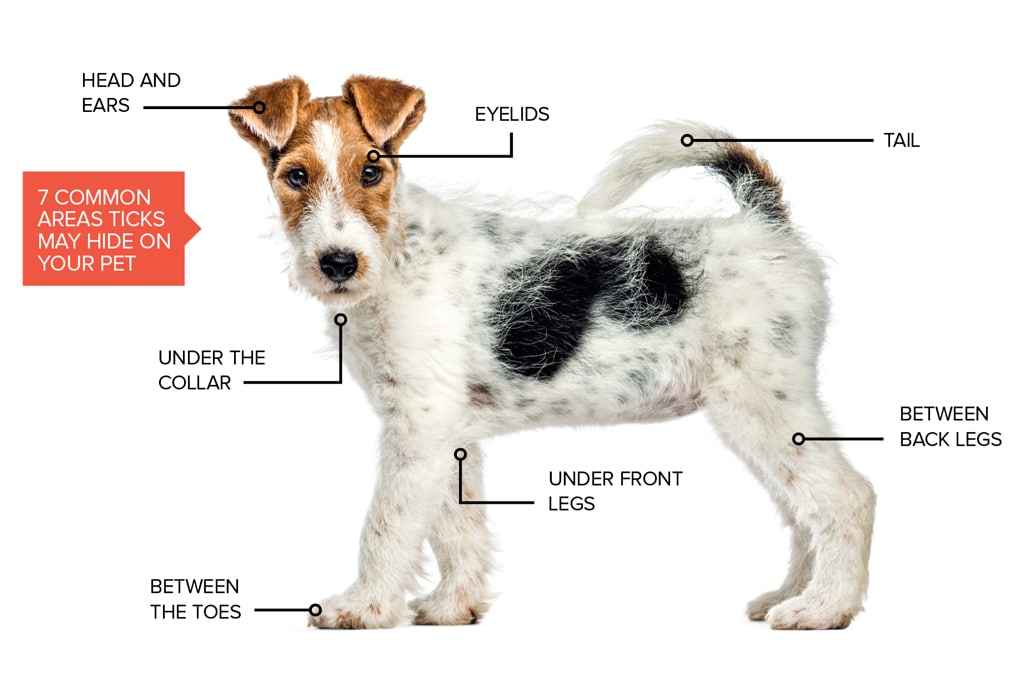- Dog CareDog LifeCommunity
- Photo Contest
Photo Contest- Giveaways
It’s Tick Season
It’s everyone’s least favourite season: tick season. Tick season usually runs from April to October, though it varies by region. Though ticks often prefer wooded areas, underbrush, long grasses, fallen leaves, and dense vegetation, they can also be found in backyards, trails, and paths. “A multitude of environmental and human factors has created a near ‘perfect storm’ over the past 20 years leading to a population explosion of ticks throughout North America, notes lymedisease.org.
If you’re spending time outdoors with your dog, a quick tick check is in order once you get home. After a tick attaches, it usually takes 24 hours to transmit the bacteria, so the sooner you can remove ticks, the better. Run your hands through your dog’s fur, paying special attention to the head, ears (inside and out), under the collar and under the legs, around the tail, and between the toes.
How to Remove a Tick
If you find a tick, the next step is removal. Using a tick remover or fine-point tweezers, grasp the tick as close to your dog’s body as possible. Do not squeeze or twist it—simply gently pull upwards with steady pressure until the tick releases. Place the tick in a closed container so you can bring it to your vet during your next visit. Your vet may want to test to see if it carries Lyme Disease or any other tick-borne diseases. Do not crush the tick with your fingers. Doing so can cause infection if you have any scratches on your skin. Once in the container, take a look at the tick to make sure it’s whole—you should be able to see its head/mouth parts. You want to make sure no part of the tick is left in your dog’s body.
Wash your hands and remember to disinfect your tweezers.
Signs of Lyme Disease:
- Fever
- Joint Pain
- Lack of Appetite
- Low Energy
- Generalized Stiffness
- Sensitivity to Touch
This article originally appeared in the award-winning Modern Dog magazine. Subscribe today!
You and your dog share a bond that nothing should interfere with
Especially not fleas, ticks and mosquitoes. K9 Advantix®II REPELS and kills fleas, ticks and mosquitoes too. If ticks are repelled, they cannot attach and transmit disease-causing organisms. Once you’ve applied flea and tick protection on your dog, you can focus on the important things, like spending time together.
You can also feel good about choosing K9 Advantix®II, because Bayer Animal Health is the official flea and tick preventive of K9s For Warriors, an organization that pairs trained shelter dogs with veterans. In fact, this year, Bayer Animal Health has already donated $150,000 to help veterans with post-traumatic stress disorder (PTSD) and traumatic brain injury (TBI) to transition back to civilian life.
K9 Advantix is a registered trademark of Bayer.
Do not use on cats.Pet Talk: Flea and Tick Control
Summer’s long, warm days make for perfect outdoor playtime for the whole family, especially our pets. However, with this abundance of outdoor activity comes an increased risk for our pets to carry fleas and ticks into our homes. Not only are these pests a nuisance, but they can also bring with them a variety of diseases harmful to both humans and animals.
Both of these pests are attracted to the warmer temperatures, making it easy to hitch a ride on Fido as he plays outside. Luckily, ticks are fairly easy to spot.
“Ticks tend to accumulate around the face and the ears, but can be on any area of the body,” said Dr. James Barr, assistant professor at the Texas A&M College of Veterinary Medicine & Biomedical Sciences.
After attaching itself to its host, a tick then takes a bite, often too painless for you or your pet to notice. However, this bite can transfer many diseases or even become infected. If this happens, a trip to the veterinarian may be necessary to treat the infection.
Fleas, on the other hand, are more difficult to find. “They can be found anywhere on the body, but like to congregate in dogs on the lower back and tail-head region,” Barr said. “Often, you may not see the fleas, but you will notice little black dots on your pet, called flea dirt.” You can differentiate flea dirt from regular dirt by putting a drop of water on the dot of “dirt.” Flea dirt will make the water a reddish color due to the digested blood.
There are a number of possibilities for the transmission of diseases by fleas and ticks. However, Barr explains that the actual percentage of bites that lead to disease transmission is unclear.
“Ticks are known to carry diseases such as Lyme disease and Rocky Mountain spotted fever,” Barr said. “The most common disease that fleas transmit to dogs are tapeworms, which are transmitted to the dogs when they ingest the fleas in an attempt to get the flea off of their body.”
Barr explains that fleas are also known to carry Yersinia pestis, the causative agent of the plague. This is a rarity, though, as it is only the case in areas that plague is common, such as the plains of the United States, and is uncommon for our pets to get.
Although the risk of disease and infection is worrisome, there are a variety of effective options available for flea and tick prevention.
“There are so many good options available now that it is possible to keep dogs and cats almost 100 percent free of fleas and ticks,” Barr said. “For example, a good preventative is regular — but not too frequent — bathing and the application of a good flea and tick preventative.”
Keep in mind that it is important to also treat the environment that your pets spend time in. Treatment of your yard, automobile, bedding, or anywhere else that your pet frequently inhabits may be necessary if fleas and ticks have infested the area.
It is best to consult with your veterinarian about which preventative products are best suited to both your pet and geographic location. By doing this, along with taking a few simple precautions, you can help keep your pets and your home free from these pests all summer long.
Dogify Your Inbox
Sign up for the FREE Modern Dog Magazine newsletter & get the best of Modern Dog delivered to your inbox.
"*" indicates required fields
By clicking the arrow, you agree to our web Terms of Use and Privacy & Cookie Policy. Easy unsubscribe links are provided in every email.


